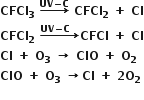Following are the features of genetic codes. What does each one indicate ? [2]
Stop codon; Unambiguous codon; Degenerate codon; Universal codon.
Stop codon -
Unambiguous codon
Degenerate codon
Universal codon
Tips: -
i. Stop codon - In genetic code. a stop codon or (termination codon) is a Nucleotide triplet with messenger RNA that signals a termination of the translation.
ii. Unambiguous codon - One codon codes for only one amino acid, hence, it is unambiguous and specific.
iii. Degenerate codon - Some amino acids are coded by more than one codon, hence the code is degenerate.
iv. Universal codon - because a codon in one organism will code for the same amino acid in another organism.






